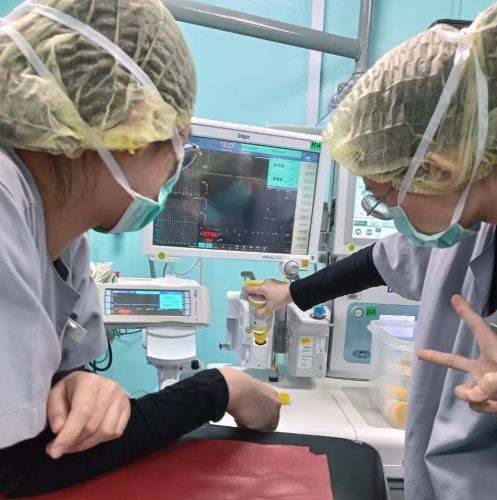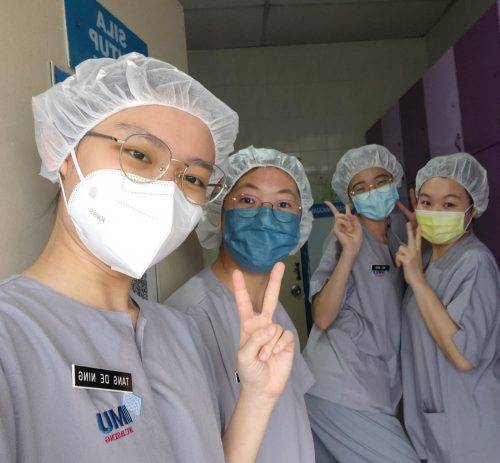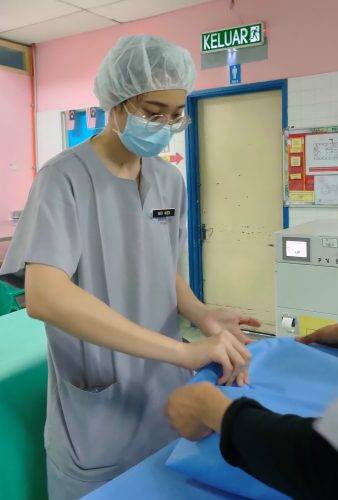Operation theatre (OT) is a specialised and controlled environment within a hospital where surgical procedures are performed. It is a dedicated space designed to provide a sterile and safe setting for surgical interventions, equipped with advanced surgical instruments, monitoring devices, and specialised healthcare professionals like surgeons, anaesthesiologists, and perioperative nurses. As nursing students in IMU, we were granted the opportunity to step into this specialised setting, the operation theatre in Hospital Tuanku Ja’afar, Seremban (HTJS) during our Semester 5 clinical posting.
Perioperative nursing refers to a specialised area of nursing that focuses on patient care throughout the entire surgical process, which includes the preoperative, intraoperative, and postoperative phases. Perioperative nurses collaborate with the interdisciplinary surgical team to provide comprehensive care, which involves preparing patients for surgery, assisting during surgical procedures, and providing postoperative care and monitoring. They possess specialised knowledge and skills in areas such as aseptic techniques, surgical instrumentation, anaesthesia administration, infection control, and patient advocacy to facilitate successful surgical outcomes and promote optimal patient recovery.
In the operation theatre, there are a total of five operating rooms (OR), a holding bay, and a post-anaesthesia care unit (PACU).
At the Operating Rooms
We were assigned to individual ORs to observe a wide range of surgical procedures and gain insight into the roles and responsibilities of each healthcare professional involved in the surgery.
In the OR, we seized the opportunity to observe and engage in communication with various healthcare professionals, particularly the circulating nurse, scrub nurse, and general anaesthesia (GA) nurse, to gain a comprehensive understanding of their respective roles and responsibilities in ensuring the seamless progression of a surgical procedure.
By learning from anaesthetists, we have the valuable opportunity to deepen our knowledge about anaesthesia, including details such as the onset and duration of different anaesthetic agents, as well as monitoring techniques to assess patients’ recovery from anaesthesia, such as monitoring end-tidal carbon dioxide (ETCO2) level, among other vital signs.
Through this experience, I have acquired the ability to effectively communicate and learn from other healthcare professionals, thereby enhancing both my knowledge and skills.
At the Post-anaesthesia Care Unit
Other than that, we are also assigned to PACU which is located adjacent to the OR and serves as the starting point for postoperative care, where patients who are either under anaesthesia or in the process of recovering from it are immediately admitted for intensive monitoring to mitigate potential postoperative complications.
In PACU, I have gained valuable knowledge and skills in immediate postoperative nursing care, including proper positioning of patients following certain surgery such as cranioplasty, the provision of comprehensive care for patients under general and spinal anaesthesia, as well as the implementation of nursing interventions to prevent postoperative hypothermia.
Here, I would like to acknowledge the efforts of our lecturer, Ms Siti Hajar, for organising a teaching and learning session on the general anaesthesia (GA) machine and operating room, facilitated by Mr Hafiy, an assistant medical officer with 10 years of experience in the operating theatre particularly in Respiratory and Haemodynamic Unit (RHU).
During the session, Mr Hafiy provided a comprehensive guide on the functions and components of the GA machine, as well as an explanation of the delivery systems for medical gases (nitrogen and oxygen) in the OR with some explanation on the Pin Index Safety System (PISS), which is a system that facilitates the connection between a specific medical gas cylinder and the delivery system of these gases.
Following that, we also had a hands-on session on refilling volatile anaesthetic agents Sevoflurane and Desflurane as well as connecting and removing the hospital pipelines from the medical gas system using Schrader connectors. From this session, I gained a profound appreciation for the operating room as a mysterious space where skilled hands delicately weave the tapestry of life, embarking on a transformative journey of healing and transformation.

At the Central Sterile Services Department
On the second week of perioperative attachment, we visited the Central Sterile Services Department (CSSD) which is a crucial department in healthcare facilities responsible for the cleaning, sterilization, and distribution of medical instruments, equipment, and supplies.

CSSD plays a vital role in maintaining a safe and sterile environment for patient care by ensuring that all reusable medical equipment and instruments are thoroughly cleaned, decontaminated, and sterilised before they are reused on patients. This includes surgical instruments, endoscopes, trays, drapes, and other reusable items used in various medical procedures.
We also had the chance to be involved in the process of packaging sterile items and packing instruments under the guidance of trained staff.
For me, CSSD is the unsung hero behind the scenes, working diligently to ensure that the instruments and equipment used in healthcare settings are safe, sterile, and ready to serve in the hands of healthcare professionals.

Clinical posting experience in the OT has been a transformative journey that has provided invaluable insights and practical knowledge. From observing various surgical procedures to learning the roles of different healthcare professionals, I have witnessed first-hand the intricate dance of teamwork, precision, and compassion that takes place within the OT. Additionally, exposure to the PACU has deepened my understanding of postoperative care and the importance of monitoring patients for any potential complications.
Through these experiences, I have also developed essential skills in communication, collaboration, and critical thinking, all of which are fundamental in the field of perioperative nursing. Armed with the knowledge gained, I hope the experience prepared us as nursing students to embark on future careers as perioperative nurses, ready to contribute to the seamless and safe delivery of surgical care.
Written by Tang De Ning (NU120)
Reviewed by Ms Siti Hajar









